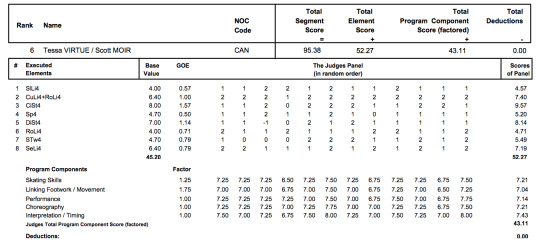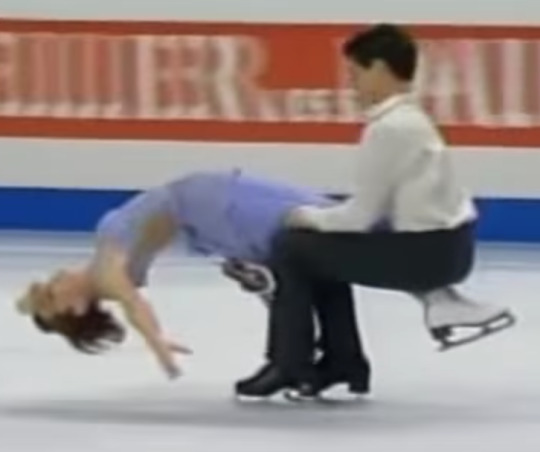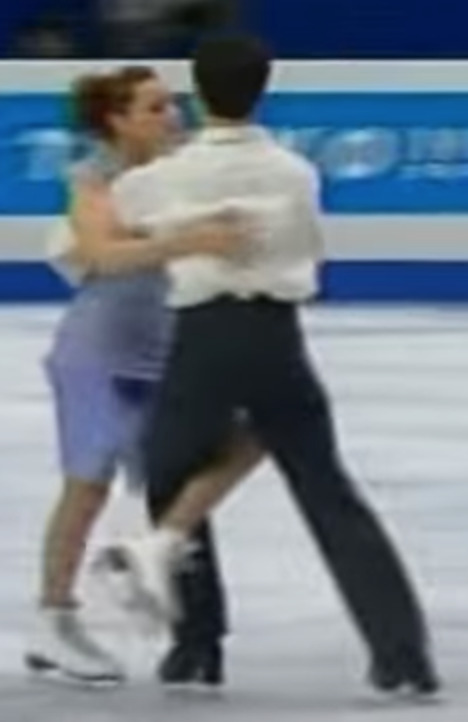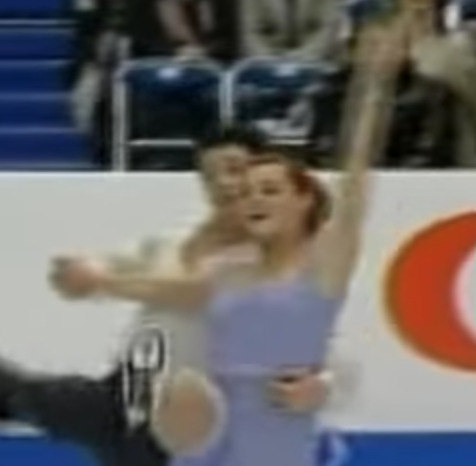#I’ve got a big ramble about body representation I’ll have to post here some day
Explore tagged Tumblr posts
Note
Have you talked much about Valse Triste? Could be fun to go back to their first senior fd!
Ok… let’s do this *cracks knuckles* *plays vm spotify playlist*
Hi anon! I mean I’ve mentioned Valse Triste I think...? But never have I ranted about it in great detail, so... um yeah... I guess I’ll do that now.
Overall thoughts:
I think as a whole Valse Triste was super fitting to who Tessa and Scott were as skaters at the time. The music had both a sense of levity and of maturity that matched the situation of being a couple of kids thrown into a competition with a whole bunch of seasoned ice dancers. I guess the main thing that stood out to me as they performed was- to steal one of the commentators’ phrasing- how automatic they look. Even after skating together for only ten years (I know, it’s such a short amount of time), they fall into hold together so easily, they always know where the other is on the ice. Moreover, they look so prepared, they go through all the elements so smoothly and precisely as if they never have to even think about what’s coming next.
They look like they have something to prove.
So I love Valse Triste, it’s probably one of my favorite programs of theirs (that’s a lie, they’re all my favorites). I guess I see it as almost a pre-cursor to Mahler. It has the same sort of mood that I can’t quite find the words for right now... a brightness and joyfulness but with the faintest undertones of melancholy (damn, I sound like a pretentious asshole).
It’s almost like with Mahler they’re just a couple of kids dancing, showing the world what they’ve got; while with Valse Triste they’re just a couple of kids dancing, showing the world that they have something to give.
Initial notes on the limitations of my analysis:
Normally I like to give my overall thoughts (see above) at the end of these nonsensical rants, but this got insanely long and in depth (and illustrated) so I’m adding a break.
ALSO, normally when I’m doing analyses it’s from a specific competition and I’m comparing vm’s scores to another team, however, with this one, I’m not really out here arguing that Tessa and Scott were lowballed, so more than anything, I’m comparing them to themselves at present. I’m not saying that they were better or worse at any given time (although obviously Valse Triste was more than ten years ago, so they did make a lot of improvements from them until 2018...)
And, as always, I am no ice dance expert so everything that I say may or may not be complete and utter bullshit.
Oh, one last thing! I get super in depth about the program and all its elements yadda yadda, but then I have a blurb about why IJS isn’t that great of a judging system at the end so that might be worth while to read even if you don’t care about the rest of my rambling soooo yeah...
Ok hi! Hope you’re doing well!
Anywho, here’s the video that I watched. I used Worlds because, in theory, that should be their best skate / the best representation of the program as a whole.
Ok, so here’s the protocol:

The judging, base values, component scoring, etc. have all obviously changed quite a bit since 2007, however I’m too lazy to re-learn IJS based on the 2007 system, so we’re just going to have to make do with my knowledge of the 2018 system. ¯\_(ツ)_/¯
Technical Element Scores (aka me blabbering incoherently because I wrote this part after doing PCS and my brain no longer wants to be organized):
The first thing I noticed about the TES when looking at the protocol was that while vm got everything called (because they’re freaking legends. Oh my god.), they didn’t have super great GOEs. I guess this kind of makes sense, particularly in the lifts you can kind of see them setting up for them rather than letting them flow with the program.
I think to give this entire shit show of a post a bit more organization, I’m going to break each element down by type and give some quick, spur-of-the-moment, rapid-fire thoughts. Kapeesh?
Lifts:
I think it’s interesting how accurate of a representations Tessa and Scott’s lifts can be to the timeline of their career. The lifts in Valse Triste are all very low to the ground. Tessa has her head almost touching the ice in the straight-line lift, for example.

While the strength and balance needed to execute the lift are very obvious from looking at it, it’s not big or reaching outward like good ol’ cunniliftus or the curved lift from Prince and Moulin Rouge do. However, this isn’t a bad thing, it’s actually more fitting with the program and with who they were as skaters at the time. While they were spectacular ice dancers even back then, they also were just a couple of kids. Having huge lifts in this particular program probably would not only not fit musically, but also almost make it seem as if vm were trying too hard... if that makes sense? (Sorry, it sounds like I’m throwing shade, I promise I’m not, I really do like the lifts and think they’re perfect given the program).
Step Sequences:
Although this isn’t necessarily a technical attribute, I guess what stood out to me most about the step sequences were their confidence. They execute each turn so exactly, there’s no long drawn out edge going into them, every thing about the step sequences ooze self-assuredness, sort of like they’re saying “We’ve practiced this ten trillion times. We know what we’re doing. We’ve got this.”
Spin:
Honestly, I don’t have all that much to comment on this. A spin is a spin is a spin. What I notice more than the spin itself is the transition into and out of it, how quickly they execute it, and the speed with which they move out of it.
Twizzles:
Again, not much to say here... they’re twizzles... Scott does get a bit off on the second one but somehow manages to save it and come out at the same time as Tessa which is pretty amazing hehehe.
Program Component Scores:
Obviously, little baby 2007 Tessa and Scott had a bit of work to do before they became the Ultimate Ice Dancers Supreme™ that they are now, so there component scores were all in the 6-7 range (which is still pretty darn respectable), rather than maxing out in the 9-10 range like they did (crying that I have to use past-tense) in their later career.
Skating Skills:
Honestly, they’re fine? I mean yes they’re very good, but they still do have some work to do. I don’t know… they have very good edges and extensions as per usual, but they do seem to lack a bit of the up-and-down smooth knee bend movement that is super representative of Canadian skating and that they have boatloads of later on in their career. On a bit of a tangent, however, areas in which they do need to improve their skating skills almost lend themselves well to the program (the power of negative space, eh?). They add to the sense of innocence and youth of the program? As in as much as I love the Valse Triste, I think a lot of its meaning and pizzazz would not at all be fitting to a present day vm.
Linking Footwork / Movement:
So I’m going to equate this to the part of the score that’s now called “Transitions” because… yeah… I just am, I’m assuming it’s more or less the same thing. The transitions were actually one of the main things I noticed upon my re-watching of this program. I don’t want to say that their transitions were simpler than they are now, per se, as that makes it seem like they were bad back in the Valse Triste days, but they kind of were… simpler. Rather than using turns and footwork to link together elements, Valse Triste more used crossovers, mini lift-like moves (Tessa looping a leg over Scott, etc.)

and body movements to move from one element to the next. Now, in some ways, this is nice- especially as someone who is not an expert on every. single. ice. dance. element. (particularly those from 2007)- as it really accentuated … oop, writing pause, Come What May just came on and I need to take a sec to look forlornly into the distance … OK SO it really accentuated where each element ended and another began. However, if we’re thinking about flow, which is something that every program really should have, more full? (that’s a weird word, I know) transitions help the more modern vm programs to seem a lot more cohesive than much of their earlier work.
Choreography:
I know that technically on the protocol sheet, “Performance” comes before “Choreography” ties in to what I just blabbered about regarding transitions so… Ok so yeah, not going to lie to y’all, I’m not really a huge fan of Marina-esque choreography. She uses a lot of hops (brief side note: apparently vm got criticism for using hops to pick up speed, but this was literally part of the choreo. What gives?) and pauses as transitions which not only breaks up the elements and takes away from the cohesiveness of the program as a whole, but also doesn’t always make sense given programs with particularly um… ethereal… music, such as Valse Triste, or Mahler, or Seasons.
That being said, something that the choreography does do very well, is being matched appropriately with the music. Although some of this obviously plays into the “Musical Interpretation / Timing” score, the fact that specific body movements or elements were chosen to go at certain points in the program as the mood and temp of the music evolves is very telling of a well-choreographed program. A prime example of this is how the circle step sequence (starting here) is set to a much more lively piece of the music, which makes sense choreographically as they are required to complete multiple turns in quick succession.
Performance & Interpretation / Timing:
So, I’m just going to lump these two together because I’m lazy, because I can, and for reasons that I’ll explain in a hot sec. As always, I think Tessa and Scott did a stellar job of performing this program. Something that they excel at more than probably any other team ever…? is portraying characters and I think this program is a prime example of that. They make use of every body movement and ensure that everything is timed perfectly with even the smallest accent in the music.
Ok so sort of a choppy transition here, but in skating, I am kind of a huge fan of facial expressions (which doesn’t necessarily make sense, as I’m totally one of those people who will beat someone up if they say that figure skating isn’t a sport, but that’s besides the point). The video is not the best quality because like… 2007… but even without being able to see specific minute details of either of their faces, you can tell that they are emoting. For example…

…here you can sort of see their faces and what they’re doing with them which is great, obvs, but more than that you can almost tell the emotion that they are feeling / portraying from their extensions and from their overall body language / movement. They really emote through their entire beings which is a skill that many ice dance teams don’t even come close to doing.
The limitations of IJS:
That hot sec that I mentioned in why I lumped Interpretation and Performance together? That one? Yeah, that hot sec is right now.
Ok, so, one of the things I struggled with in trying to separate out each specific program component to look at is that any skating program is meant to be viewed as an entire entity. Yes, there are individual elements and individual components that all make up the program, but any skater and choreographer worth their salt (is that a saying? I don’t know) will try to add some sense of musicality and flow to a program, whether it be through having a storyline for the program or simply having certain movements that tie everything in the program up in a neat package from beginning to end.
This being the case, it’s really hard to look at a program and parse out which movements are part of choreography, what pieces are thought up by the skater themself as part of the performance, etc. So… yeah it was hard.
Another thing to note is that judging bias is a real thing. In this case I don’t think any biases necessarily came from judges being paid off or playing favorites or anything, but simply due to expectations. It’s not even anything to do with vm themselves, but with every newer senior team. First of all, when a team is placed higher in world rankings, they will skate in a later group at Worlds. This means that in the later groups there is a much higher expectation for the teams to do better and thus when a newer / lower ranked team is particularly good, the judges might be blindsided a bit and not give them that high a score simply because they did not expect that team to be good and consequentially do not see them as good (psychology, anyone?).
Another result of being in an earlier group is that the judges and tech panel aren’t going to want start right off the bat by giving all +3 GOEs and 10.00 component scores. There needs to be somewhere for the scores to go throughout the competition. So pretty much the earlier teams might be scored particularly harshly as they are pretty much setting the bar and being a baseline off of which all the other teams are going to be judged for the rest of the competition. (I mean technically, teams aren’t supposed to be compared to one another but like………)
Wow wow wow ok you made it! Yup, that was very long and probably made no sense and had like twenty different moods because I skipped around while writing it, but maybe you thought it was worth the twelve hours it took you to get through it? Probably not...
Anyway, thank you so much anon for inspiring my ranting :)
#Anonymous#anon#ask#rants and stuff#valse triste#tessa and scott#analyses#wow#I hate that I just wrote this whole thing#If I put this much effort into the rest of my life#...I could be so successful#ok#well have a nice night all!
13 notes
·
View notes